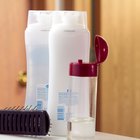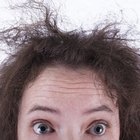
Humans normally lose more than 100 hairs every day, shedding to make space for growth of new hair. But broken hairs are a sign of fragile, unhealthy hair. Hair breakage, which commonly occurs at the roots, usually results from weakened hair shafts caused by improper brushing, excessive heat, harmful hair styles, chemical processes or sun damage. Once hair is broken, it cannot be repaired. Use gentle handling and proper grooming habits to eliminate breakage and restore healthy, manageable hair.
Step 1
Shampoo your hair with a moisturizing shampoo. Lather your hair gently with your fingertips, and never scrub your scalp with your fingernails.
Step 2
Follow every shampoo with a moisturizing conditioner or cream rinse. Leave the conditioner in your hair for three to five minutes or as directed on the container.
Step 3
Wash your hair with an itch-control shampoo if your scalp is dry, or use a dandruff shampoo if you have an itchy scalp and dandruff. Don't scratch your scalp as this damages the roots of your hair and creates breakage.
Step 4
Avoid drying your hair with a rough towel because wet hair is fragile and easily broken. Blot your hair with a soft towel or a microfiber towel, with no twisting or pulling.
Step 5
Detangle wet hair gently with your fingers. Don't use a comb or brush until your hair is nearly dry.
Step 6
Comb your hair gently using a wide-tooth comb that won't pull your hair. If you use a brush, look for one with widely-spaced bristles and plastic ball tips to prevent friction. Don't use a brush that causes discomfort when you brush it across your palm.
Step 7
Treat your hair to a deep-conditioning treatment every three to five days. Apply a deep conditioner after shampooing, then leave it in your hair for 10 to 15 minutes. Be sure the entire hair shaft, including the roots of your hair, are coated. Once your hair is healthy and breakage no longer occurs, deep condition with a protein conditioner every seven to 10 days.
Step 8
Protect your hair from sunlight because exposure to UV rays damage the hair and cause breakage. Wear a soft, floppy sunhat, or apply a leave-in conditioner.
Step 9
Wear a soft scarf to protect your hair from windy weather. Wind dries the hair and creates tangles that are difficult to remove without aggressive combing. If your hair tangles, dip your fingertips in conditioner, then remove the tangle carefully, working from the ends of the hair toward the scalp.
Step 10
Avoid hairstyles that damage the hair shaft at the roots, such as braids, tight up-dos or dreadlocks. Never tease your hair. Don't sleep with clips, rubber bands, barrettes or hair combs.
Step 11
Minimize use of chemical processes as much as possible. Hair dyes, as well as straightening and permanents, damage the hair shaft and lead to breakage. If possible, visit a professional hairstylist for application of chemical processes.
Step 12
Minimize use of heated styling tools. Apply a heat-protectant product to your hair before using heated tools. Set tools on warm or cool, and avoid hot air. If you use a hair dryer, hold the dryer 6 to 10 inches from your head. Direct the air toward the middle or ends of the hair -- not the roots.
Related Articles

Tips on Reducing Flyaway Hair

How to Get Frizz-Free Hair When Your ...

How to Make Gray Hair Soft & Manageable

How to Remove Dandruff With Baking ...

How to Stop Your Hair From Looking Dry ...

How to Get Elmer's Glue Out of Hair

How to Remove Human Hair Mats

How to Take Care of Yaki Hair

How to Deal with an Itchy Weave

How to Moisturize Dry Hair Caused by ...

How to Do Pinup Curls

How to Deep Condition Extensions

How to Get Hair Ready for Braids

How to Make a Weave Stop Itching

How to Do an at Home Wash & Set Without ...

How to Control Frizzy Hair for ...

How to Cure Rough and Dry Afro Hair

Hair Tips for Super Dry Hair

How to Wash African-American Braids

How to Get a Healthy Spiral Perm
References
- Hair Care: An Illustrated Dermatologic Handbook; Zoe Diana Draelos
- Aging Hair; Ralph M. Trüeb, Desmond John Tobin; Editors
- Encyclopedia of Women's Health; Sana Loue, Martha Sajatovic, Keith B. Armitage, Editors
- Hair Care Rehab: The Ultimate Hair Repair and Reconditioning Manual; Audrey Davis-Sivasothy
- Eucerin: Dry and Itchy scalp: Symptoms, Causes and Solutions
Tips
- See a dermatologist if regular, at-home treatment doesn't minimize your hair breakage. Weakened hair is sometimes caused by certain medications or treatable illnesses.
- Similarly, check with your physician if home treatment doesn't minimize a dry, itchy scalp.
Writer Bio
M.H. Dyer began her writing career as a staff writer at a community newspaper and is now a full-time commercial writer. She writes about a variety of topics, with a focus on sustainable, pesticide- and herbicide-free gardening. She is an Oregon State University Master Gardener and Master Naturalist and holds a Master of Fine Arts in creative nonfiction writing.
Photo Credits
Ralf Nau/Digital Vision/Getty Images